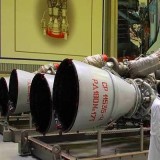Russia Trials Satellite Link to Extend Operational Reach of Long-Range Drones

{loadposition bannertop}
{loadposition sidebarpub}
On April 23, 2025, Russian news agency TASS reported that the design bureau Intelligent Devices (Intelp) has launched testing of the first national real-time satellite communication system developed for tactical long-endurance unmanned aerial vehicles (UAVs). This system is intended to provide Russian UAVs with increased operational autonomy, enabling them to operate beyond the limits of line-of-sight communication or ground-based relays, and thereby significantly expand their range. The initiative is part of a broader strategy to enhance national capabilities in a field that has become crucial for modern conflicts and operations in remote regions such as the Arctic or maritime zones.
Follow Army Recognition on Google News at this link
The system operates mainly in the Ku band, integrating a compact 35 cm parabolic antenna with tracking and control modules into a single unit under 8 kg, enabling stable satellite communication for UAVs in motion. (Picture source: Vitaly V. Kuzmin)
Specializing in communication technologies, Intelp has developed a solution compatible with compact and mobile subscriber stations, equipped with a reduced-aperture antenna. According to the bureau’s General Director, Alexander Kondrashina, the system complies with regulatory emission standards while optimizing frequency usage through code compression techniques. He also noted that technology ensures stable connectivity at the edge of coverage zones of geostationary satellites, as well as with future high-elliptical orbit constellations, making it suitable for reliable communications even at high latitudes. This makes it particularly relevant for deployment along the Northern Sea Route and in maritime areas such as the Russian Far East, the Baltic Sea, the Black Sea, and the Caspian Sea.
Unmanned aviation expert Denis Fedutinov highlighted the significance of this technological development, explaining that satellite communication integration enables UAVs to operate far beyond the range of conventional radio links. He emphasized that the system’s compact size and weight allow for its integration not only on large drones but also on tactical platforms such as the Orion (Inokhodets), Sirius (Inokhodets-RU), Helios-RLD, and future models under development as part of the Altius program. This capability marks a first for the Russian UAV industry.
Technically, the system primarily operates in the Ku frequency band, with a version for the C band also planned. The equipment combines a 35 cm diameter parabolic antenna with a feedhorn, a transceiver, control and positioning modules, and an intelligent tracking system into a single integrated unit. This allows a UAV to maintain communication with geostationary satellites while in motion. The antenna can rotate at up to 200 degrees per second, maintaining a stable connection even on high-speed UAVs or small marine vessels. The total weight of the subscriber station is under 8 kg.
Intelp also stated that the system allows for rapid reconfiguration of communication channel parameters at the software level. With a built-in router, proprietary IP architecture, and a mechanism for optimizing data structure and transmission volume, the system can be easily integrated into any existing data network infrastructure. This adaptability aligns with growing demands for modularity in modern command and control systems.
Compared to conventional systems, this solution offers stable satellite coverage beyond line of sight, including in Arctic regions, due to its compatibility with high-elliptical orbits. Internationally, the United States has maintained leadership in this area for decades, equipping UAVs like the MQ-9 Reaper and RQ-4 Global Hawk with SATCOM links through WGS (Wideband Global SATCOM) satellites. Israel has implemented similar capabilities on its Heron TP drones, while Turkey has equipped its Bayraktar Akinci and Anka UAVs with Ku-band satellite links. China, though less transparent about technical details, has incorporated SATCOM into MALE-class drones such as the CH-5 and is developing its own low-Earth orbit constellations. The United Kingdom is also integrating satellite communication capabilities into its MQ-9B-based Protector RG Mk1.
In response to these global advancements, Russia aims to bridge its gap in satellite communications for UAVs by making such capabilities available to lighter and more versatile platforms. This announcement comes as President Vladimir Putin, during a meeting on UAV development in January, ordered additional funding for accelerating the deployment of low-Earth orbit satellite constellations.
The start of testing for this first satellite communication system for tactical long-endurance UAVs represents a significant step in modernizing Russia’s drone capabilities. Its compact design, software flexibility, and ability to operate in underserved areas position it as a potentially transformative tool in Russia’s UAV operations. It also reflects a broader international trend toward increasingly autonomous drone systems capable of conducting complex missions without reliance on terrestrial infrastructure.

{loadposition bannertop}
{loadposition sidebarpub}
On April 23, 2025, Russian news agency TASS reported that the design bureau Intelligent Devices (Intelp) has launched testing of the first national real-time satellite communication system developed for tactical long-endurance unmanned aerial vehicles (UAVs). This system is intended to provide Russian UAVs with increased operational autonomy, enabling them to operate beyond the limits of line-of-sight communication or ground-based relays, and thereby significantly expand their range. The initiative is part of a broader strategy to enhance national capabilities in a field that has become crucial for modern conflicts and operations in remote regions such as the Arctic or maritime zones.
The system operates mainly in the Ku band, integrating a compact 35 cm parabolic antenna with tracking and control modules into a single unit under 8 kg, enabling stable satellite communication for UAVs in motion. (Picture source: Vitaly V. Kuzmin)
Specializing in communication technologies, Intelp has developed a solution compatible with compact and mobile subscriber stations, equipped with a reduced-aperture antenna. According to the bureau’s General Director, Alexander Kondrashina, the system complies with regulatory emission standards while optimizing frequency usage through code compression techniques. He also noted that technology ensures stable connectivity at the edge of coverage zones of geostationary satellites, as well as with future high-elliptical orbit constellations, making it suitable for reliable communications even at high latitudes. This makes it particularly relevant for deployment along the Northern Sea Route and in maritime areas such as the Russian Far East, the Baltic Sea, the Black Sea, and the Caspian Sea.
Unmanned aviation expert Denis Fedutinov highlighted the significance of this technological development, explaining that satellite communication integration enables UAVs to operate far beyond the range of conventional radio links. He emphasized that the system’s compact size and weight allow for its integration not only on large drones but also on tactical platforms such as the Orion (Inokhodets), Sirius (Inokhodets-RU), Helios-RLD, and future models under development as part of the Altius program. This capability marks a first for the Russian UAV industry.
Technically, the system primarily operates in the Ku frequency band, with a version for the C band also planned. The equipment combines a 35 cm diameter parabolic antenna with a feedhorn, a transceiver, control and positioning modules, and an intelligent tracking system into a single integrated unit. This allows a UAV to maintain communication with geostationary satellites while in motion. The antenna can rotate at up to 200 degrees per second, maintaining a stable connection even on high-speed UAVs or small marine vessels. The total weight of the subscriber station is under 8 kg.
Intelp also stated that the system allows for rapid reconfiguration of communication channel parameters at the software level. With a built-in router, proprietary IP architecture, and a mechanism for optimizing data structure and transmission volume, the system can be easily integrated into any existing data network infrastructure. This adaptability aligns with growing demands for modularity in modern command and control systems.
Compared to conventional systems, this solution offers stable satellite coverage beyond line of sight, including in Arctic regions, due to its compatibility with high-elliptical orbits. Internationally, the United States has maintained leadership in this area for decades, equipping UAVs like the MQ-9 Reaper and RQ-4 Global Hawk with SATCOM links through WGS (Wideband Global SATCOM) satellites. Israel has implemented similar capabilities on its Heron TP drones, while Turkey has equipped its Bayraktar Akinci and Anka UAVs with Ku-band satellite links. China, though less transparent about technical details, has incorporated SATCOM into MALE-class drones such as the CH-5 and is developing its own low-Earth orbit constellations. The United Kingdom is also integrating satellite communication capabilities into its MQ-9B-based Protector RG Mk1.
In response to these global advancements, Russia aims to bridge its gap in satellite communications for UAVs by making such capabilities available to lighter and more versatile platforms. This announcement comes as President Vladimir Putin, during a meeting on UAV development in January, ordered additional funding for accelerating the deployment of low-Earth orbit satellite constellations.
The start of testing for this first satellite communication system for tactical long-endurance UAVs represents a significant step in modernizing Russia’s drone capabilities. Its compact design, software flexibility, and ability to operate in underserved areas position it as a potentially transformative tool in Russia’s UAV operations. It also reflects a broader international trend toward increasingly autonomous drone systems capable of conducting complex missions without reliance on terrestrial infrastructure.





